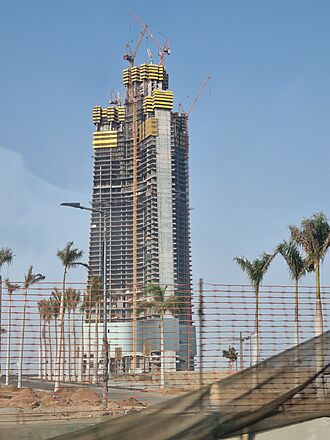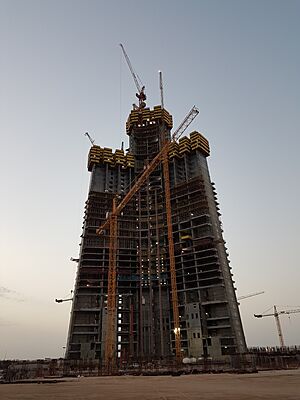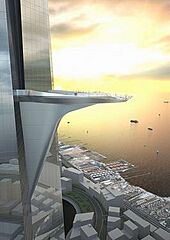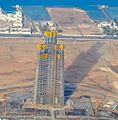Jeddah Tower facts for kids
Quick facts for kids Jeddah TowerBurj Jeddah |
|
|---|---|
|
برج جدة
|
|

Jeddah Tower in May 2021 during construction pause
|
|
| General information | |
| Status | Under construction |
| Type |
|
| Architectural style | Neo-futurism |
| Location | Jeddah, Saudi Arabia |
| Coordinates | 21°44′2.4000″N 39°4′58.2240″E / 21.734000000°N 39.082840000°E |
| Construction started | 1 April 2013 |
| Estimated completion | 2028 |
| Cost | SR4.45 billion (US$1.23 billion) (preliminary) |
| Owner | Jeddah Economic Company; Kingdom Real Estate Development |
| Management | CBRE Group |
| Height | |
| Architectural | At least 1,008 m (3,307 ft) |
| Roof | At least 1,008 m (3,307 ft) |
| Top floor | 668 m (2,192 ft) (if completed as planned) |
| Observatory | 652 m (2,139 ft) |
| Technical details | |
| Structural system | Reinforced concrete and steel, all-glass façade |
| Floor count | 165 |
| Floor area | 243,866 m2 (2,624,950 sq ft) |
| Lifts/elevators | 59 (55 single deck and 4 double deck), made by Kone |
| Design and construction | |
| Architect | Adrian Smith |
| Developer | Jeddah Economic Company (JEC) |
| Engineer | Langan International (sub-grade and transportation planning) |
| Structural engineer | Thornton Tomasetti |
| Main contractor | Saudi Binladin Group |
The Jeddah Tower or Burj Jeddah (Arabic: برج جدة) is a huge skyscraper being built in Jeddah, Saudi Arabia. It was once called the Kingdom Tower. This amazing building is planned to be the first to reach a height of 1-kilometre-tall (3,281 ft). When finished, it will be the tallest building in the world. It will stand 180 m (591 ft) taller than the Burj Khalifa in Dubai.
The tower is a main part of the Jeddah Economic City project. This project is located in the northern part of Jeddah. Construction on the tower started again in 2023 after being paused for almost five years.
The design of the Jeddah Tower was created by American architect Adrian Smith. He also designed the Burj Khalifa. The idea for this project came from Saudi Arabian prince Al-Waleed bin Talal. He is the chairman of Kingdom Holding Company (KHC). This company is a partner in the Jeddah Economic Company (JEC). JEC was created in 2009 to build the Jeddah Tower and the surrounding city.
Work on the tower stopped in January 2018. This was due to problems with the construction company. At that time, about one-third of the tower was built. In September 2023, new plans were made to finish the project.
Contents
About the Jeddah Tower
The Jeddah Tower is designed to be at least 1,008.2 metres (3,308 ft) tall. Its exact height is a secret for now, just like the Burj Khalifa's was. At about one kilometer, it will be the tallest building in the world. It will be 180 m (591 ft) taller than the Burj Khalifa in Dubai.
The tower sits on a 50-hectare (120-acre) piece of land. This area, along with other buildings, is the first part of the Jeddah Economic City project. This big project will cover 5.2 km2 (2.0 sq mi) of undeveloped land. It is about 20 km (12 mi) north of Jeddah. The Jeddah Economic City was designed by HOK Architects. It is expected to cost at least SR75 billion (US$20 billion). It might take around ten years to build.
This development aims to create a whole new area in Jeddah. The tower will mainly house a Four Seasons hotel. It will also have Four Seasons apartments, office spaces, and luxury homes. The tower will also feature the world's highest observation deck.
Adrian Smith of Adrian Smith + Gordon Gill Architecture (AS + GG) is the main designer. He also designed the Burj Khalifa. Thornton Tomasetti is the company in charge of the tower's structure. Environmental Systems Design, Inc. (ESD) helps with the building's engineering systems.
On August 2, 2011, Kingdom Holding announced that Saudi Binladin Group (SBG) would build the tower. Construction was expected to take 63 months. However, some people think it will take longer. SBG also invested SR1.5 billion (US$400 million) in the project.
Tower Design and Features
Overcoming Building Challenges
Building such a tall structure comes with many challenges. These include how far elevators can go and how much the building might sway in the wind. Another issue is that concrete can shrink, making floors uneven. Very tall buildings also need a large central core. This core supports the structure and holds many elevators.
The Jeddah Tower's smooth, sloped design helps with these problems. This shape makes it more aerodynamic than "stepped" buildings like the Burj Khalifa. This means it handles wind better. Wind tunnel tests helped figure this out. The tower will also use very strong concrete. This concrete will be several meters thick in some parts. This helps prevent too much swaying. It also protects the building from damage.
Shape and Appearance
The Jeddah Tower has a triangular shape and a sloped outside. This design helps reduce the force of the wind. Its large surface area also makes it good for homes. The tower's design is meant to look like a desert plant growing upwards. This symbolizes Saudi Arabia's growth. It also highlights Jeddah's role as a gateway to the holy city of Mecca.
The exact number of floors is not official. However, the architect, Adrian Smith, said it would have about 50 more floors than the Burj Khalifa. The Burj Khalifa has 163 floors. This means Jeddah Tower could have over 200 floors.
The tower will also have a large outdoor balcony. This is called the sky terrace. It is about 30 m (98 ft) wide. It will be on level 157 for private use. It was first planned as a helipad, but it was not suitable for helicopters. The air near the top of the tower will be cooler than at ground level. This will help cool the building naturally. Strong winds at high altitudes also influenced the tower's design. The tower will be built so that no side faces the sun directly. It will also reuse water from its air conditioning system for watering plants.
Elevator System
The building will have 59 elevators. Five of these will be double-deck elevators. There will also be 12 escalators. The elevators are made by the Finnish company Kone. High-speed elevators will take people to the world's highest observation deck. They will travel at speeds up to 10 metres (33 feet) per second (36 km/h or 22 mph).
To manage the many elevators, the tower will have three sky lobbies. Here, people can switch elevators to reach different parts of the building. No single elevator will go from the very bottom to the very top floor. Lessons from building the Burj Khalifa helped design the Jeddah Tower. This includes planning for mechanical, electrical, and plumbing systems. It also helped with following local and international building codes.
Economic Impact
Saudi Arabia is seeing a growing need for homes. The government plans to invest US$67 billion (SR251 billion) to build 500,000 homes. About 900 new homes are needed every day to keep up with the fast-growing population.
The Jeddah Tower and the surrounding city are part of a bigger plan. Saudi Arabia is investing over US$400 billion (SR1.5 trillion) in new roads and buildings. For example, a new airport terminal is being built at King Abdulaziz (Jeddah) International Airport. This will cost US$7.2 billion (SR27.1 billion). These projects aim to improve the country's infrastructure.
The Jeddah Tower and City are also designed to be environmentally friendly. They will use modern technology to have a low carbon footprint. However, some people argue that money should be spent on education instead of skyscrapers. They see the tower as a symbol of pride rather than a real need.
Some economists have noticed a pattern. Very tall skyscrapers are often finished just before a difficult economic time. This is because they start when money is easy to get. But they finish when the economy might be struggling. Examples include the Empire State Building during the Great Depression. The Burj Khalifa was also built during the Great Recession. This idea is sometimes called the "skyscraper index."
Images for kids
See also
 In Spanish: Jeddah Tower para niños
In Spanish: Jeddah Tower para niños
- List of tallest buildings
- List of future tallest buildings
- List of tallest buildings in Saudi Arabia
- The Illinois












